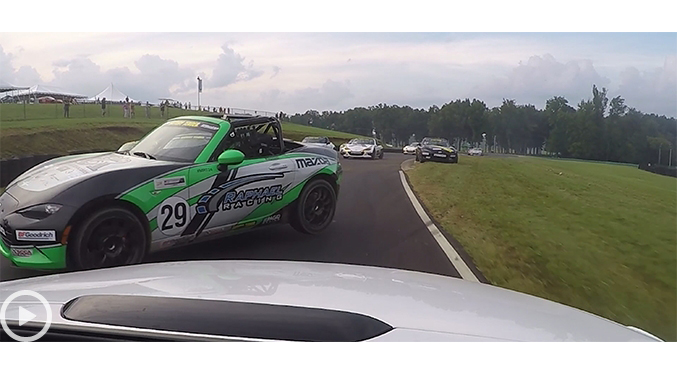Race restarts offer a huge opportunity to make passes. The field is bunched up, tires are a little cold and sometimes the door opens. You can often make more passes in the first lap or two after a restart than at any other time in a race.
That same opportunity for passing is an opportunity for contact. Cars are close together and many drivers will be trying to capitalize on the situation. As a result, crashes are the most common on starts and restarts. That’s doubly true if you race in a spec class that has big fields because there are more cars bunched up.
In this video we see a driver (black/yellow car) execute a few passes immediately after a restart. Perhaps emboldened by this success, he makes an overly optimistic move near the beginning of the second green flag lap. That move punts a car, which creates a melee with so many cars right together. Winding Road Team TFB driver Tom Martin (camera car) does a nice job of threading the needle.
We’ve seen something like this in all sorts of racing from Pirelli World Challenge to Indycar to Spec Miata. When you have a lot of similar cars with talented drivers, the field runs in groups of cars that are very close together. That is even more true on restarts, where the entire field is close. What changes all too often is that one or two drivers get extra aggressive trying to take advantage of that closeness. That’s a low percentage game, so, cliche or not, any rational coach would advise being extra careful attempting aggressive passes in corners on a restart.
As we’ve said before, you need to be especially thoughtful when switching from normal rhythm driving, where you have time to set up passes can can think ahead about avoiding risky moves, to carpe diem driving, where an small opportunity suddenly opens up and you have to instantly decide whether to take it or not given the risk.
But, that’s not the interesting point from this video. When we cut to Tom’s rearview camera, you see the car behind Tom still trying to race when perhaps it should be clear that something has gone wrong ahead. First you see the following car plow into Tom. Then, seconds later, he seems to attempt to pass Tom while going through the spinning wreckage. That, shall we say, doesn’t end well. Maybe the video doesn’t show the complete picture (when cars are spinning it is tough to predict their paths and no single video shows the complete situation). But we’d still say this is a reminder that it is important on a restart to be heads up, prepare to switch quickly to yellow flag mode, and live to fight another day.
Yellow flag mode doesn’t usually involve yellow flags. The corner workers can’t get the flags out that fast and the corner stations aren’t always in the perfect spot. Yellow flag mode is a driving style that involves a slightly slower pace so that you have more margin for sudden avoidance moves and it involves driving to avoid risk, not cutting it as close as possible to maintain momentum.
If you are overly focused on finding carpe diem situations, and not thinking about yellow flag situations at all, you are unlikely to respond correctly. That generally doesn’t help you or your fellow racers.


